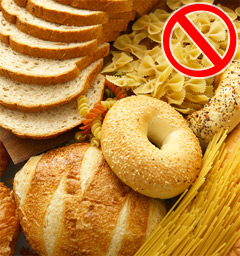|
 , ,
Font size |
Gluten Intolerance: Symptoms & Management Tips

Gluten is a protein composite consisting of a gliadin fraction (alcohol soluble)
and a glutenin fraction (only soluble in dilute acids or alkali). It gives
elasticity to dough helping it to rise and to keep its shape. Gluten occurs in
wheat and other grains, including barley and rye, and in foods or drinks derived
from them, but not in corn, rice, or oats.
It�s can be found in any product containing wheat,
including soy sauce, salad dressing, pickles, gravy and french fries.
It works by attacking the villi, the finger-like structures which line the small
intestine, resulting in stomach problems and mal-absorption of nutrients. Left
untreated, the disease can cause severe health conditions and complications such
as mental illness, osteoporosis, Anemia, miscarriage,
and even cancer.
Common Symptoms of Gluten Intolerance
-
Gastrointestinal (GI),
stomach, and digestive problems including one or some of the following: Gas, bloating,
queasiness, abdominal cramping, constipation, diarrhea, or an alternating
combination of both - IBS (Irritable
Bowel Syndrome).
-
Headaches and/or migraines:
If your migraine starts
within an hour or two of ingesting food that contains gluten, it's highly
indicative of a gluten sensitivity.
-
Fibromyalgia: Inflammation
of the connective tissue is one of the strongest symptoms of a gluten
intolerance. Essentially, the body thinks gluten is an enemy and will send out
antibodies to destroy it. Those antibodies destroy the lining of the stomach and
intestines. Just like with joint pain, the inflammation could present itself in
any part of the body. If a doctor told you that you have fibromyalgia, try
eliminating gluten and see how you feel.
-
Emotional issues involving
chronic irritability and sudden, irrational mood shifts.
-
Neurological issues, including
dizziness, difficulty balancing, and peripheral neuropathy affecting nerves
outside the central nervous system and resulting in pain, weakness, tingling or
numbness in the extremities.
-
Fatigue, whether chronic
or almost after every meal. Chronic fatigue syndrome (CFS) is, like
fibromyalgia, a syndrome, not a disease. If that's what you're diagnosed with,
it means your doctor can't locate the cause of your fatigue.
All these symptoms are common to other health issues and diseases. That's why
symptoms alone as a diagnosis is perplexing.
Stress is often cited as one of the cause of these symptoms. Instead of
anti-depressants, sleeping aids or anti-anxiety meds (some of which contain
gluten), take a good look at what you're eating.
Management Tips: Guidelines
of a Gluten-free Diet
-
 Avoid all foods made from wheat, rye, bran, enriched flour, bulgur and
barley (cereals, breads, pasta, croutons, crackers, cakes, cookies..) Avoid all foods made from wheat, rye, bran, enriched flour, bulgur and
barley (cereals, breads, pasta, croutons, crackers, cakes, cookies..)
-
Avoid beer and other grain-based alcohol.
-
Avoid oats. Some oat preparations can be contaminated with wheat. In
some cases small quantities of oats are allowed into the diet under medical
supervision. Also some food products can be produced in facilities that
manufacture gluten.
-
Use caution with processed foods that may contain gluten (canned soups,
salad dressings, soy sauce, seasonings, ice cream, candy bars, instant
coffee, ketchup, mustard, processed and canned meats, sausages...)
-
Read the food and product labels before buying or consuming any product.
Manufacturers are required to provide information about the ingredients used
to make their food products. Gluten containing fillers can be found in some
prescription and over-the-counter medications. Gluten also can be found in
many vitamin products, tablets, vitamin preparations and even cosmetic
products such as lipstick, lip gloss, chapstick and toothpaste.
-
Avoid milk and other dairy products that contain lactose. Untreated
individuals with celiac disease often are lactose intolerant. With
successful treatment, dairy products can be reintroduced slowly into the
diet.
-
Other cereals such as corn, millt, sorghum, teff, rice, and wild rice
are safe for patients to consume. Non cereals such as amaranth, quinoa or
buckwheat are also harmless.
Non-cereal carbohydrate-rich
foods such as potatoes and bananas, tapioca, garbanzo beans are safe to
consume. They do not contain gluten and do not trigger symptoms.
-
It is recommended to take vitamin and mineral supplements to
reduce the risk of deficiencies caused by the disorder.
-
Substitute recipe ingredients
and adjusting time and temperature used for baking.
Take note that, if this chronic digestive disorder is not properly treated, the
person's quality of life can be seriously undermined.
In the words of Natalia
Jill, a fitness trainer, a Licensed Sports Nutritionisth and a
CELIAC patient "I do avoid gluten (which is the protein found in wheat
rye and barley) not only because I am a celiac, but because when eating
unprocessed natural foods, those are naturally gluten free anyway."
|
Dated 15 March 2014
Related Links
|









